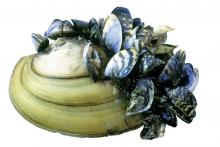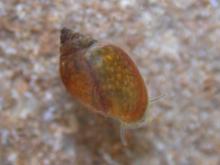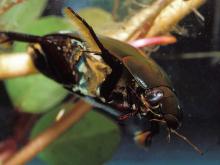Aquatic Invertebrates
Media

Species Types
Scientific Name
Bivalve molluscs in order Unionoida
Description
Secretive and seldom seen, freshwater mussels are extraordinarily diverse in Missouri. We have nearly 70 species within our borders. Many are declining, and several are endangered.
Media

Species Types
Scientific Name
Dreissena polymorpha
Description
Zebra mussels are named for their shells, which have alternating light and dark bands. They are a highly invasive nonnative species. Learn how to prevent their spread.
Media

Species Types
Scientific Name
Over 20 Missouri species in former subclass Prosobranchia
Description
Gilled snails are one of two main groups of aquatic snails in Missouri (the other group is the "lunged" snails). Gilled snails, or prosobranchs, breathe with gills and possess a hard trapdoor-like operculum. They are most common in the Ozarks.
Media

Species Types
Scientific Name
Over 30 Missouri species in former subclass Pulmonata
Description
Pulmonate, or lunged snails breathe via a lunglike pulmonary cavity, and they lack the hard trapdoor-like operculum found in gilled snails. Except for in the Ozarks, pulmonate snails predominate in most of the aquatic regions in our state.
Media

Species Types
Scientific Name
Gyraulus, Helisoma, Menetus, Micromenetus, Planorbula spp.
Description
Ramshorn snails are easy to identify at a glance, because the shell is a flat, disklike coil. Like other pulmonate aquatic snails, they lack the hard horny “trapdoor” possessed by other types of aquatic snails.
Species Types
Scientific Name
Various species in the genus Hydra
Description
We’ve all seen aquariums and pictures of tropical saltwater invertebrates such as corals, jellyfish and anemones—but did you know that there are similar creatures living in the freshwater habitats of Missouri?
Media

Species Types
Scientific Name
Various species in the subclass Hirudinea
Description
Most people are repulsed by leeches. But once you get past the fact that many species are parasitic bloodsuckers, you will discover that they are fascinating creatures with an important role in nature.
Media

Species Types
Scientific Name
Freshwater species in the phylum Bryozoa
Description
Bryozoans are tiny, filter-feeding invertebrates. They create colonies that can be mossy, branching, or round and jellylike.
Media

Species Types
Scientific Name
Species in the beetle family Gyrinidae
Description
Groups of whirligig beetles swim on the water surface in quick, random patterns, searching for food. They have two pairs of eyes — one pair above water, one pair below — to help them quickly and accurately capture their prey.
Media

Species Types
Scientific Name
Species in the beetle family Dytiscidae
Description
Like many aquatic insects, these large oval beetles prey voraciously on other aquatic organisms. Excellent swimmers, they fly well, too, and are often attracted to lights.
See Also
About Aquatic Invertebrates in Missouri
Missouri's streams, lakes, and other aquatic habitats hold thousands of kinds of invertebrates — worms, freshwater mussels, snails, crayfish, insects, and other animals without backbones. These creatures are vital links in the aquatic food chain, and their presence and numbers tell us a lot about water quality.





















